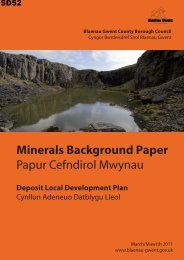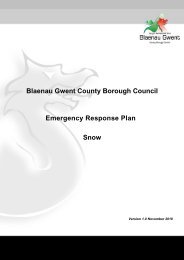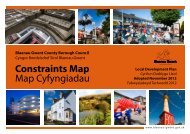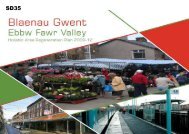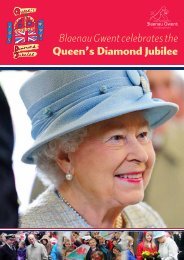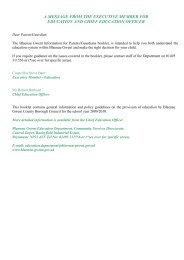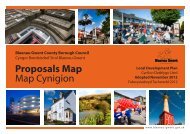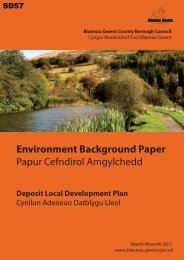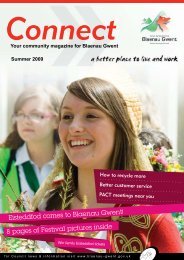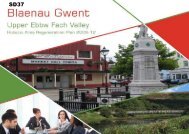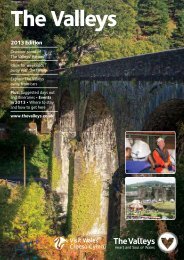SD55 - Blaenau Gwent County Borough Council
SD55 - Blaenau Gwent County Borough Council
SD55 - Blaenau Gwent County Borough Council
Create successful ePaper yourself
Turn your PDF publications into a flip-book with our unique Google optimized e-Paper software.
LEISURE BACKGROUND PAPER<br />
• allotments, community gardens, and city (urban) farms<br />
• cemeteries and churchyards;<br />
• accessible areas of countryside in the urban fringe<br />
• civic spaces<br />
• water<br />
NATURAL GREEN SPACE PROVISION<br />
Providing Accessible Natural Greenspace in Towns and Cities’ (Green Space<br />
Toolkit) – Countryside <strong>Council</strong> for Wales<br />
5.5 Greenspaces are publicly accessible open spaces that have a ‘predominantly<br />
natural’ character. The benefits of such places are explored in the ‘Greenspace<br />
Toolkit’, launched by the Countryside <strong>Council</strong> for Wales (CCW) in May 2006. The<br />
Toolkit not only outlines the environmental and wider social benefits that accrue<br />
from Greenspace, but also defines provision standards (see Table 1) and proposes<br />
ways in which these standards might be measured.<br />
Table 1 - Natural Greenspace standards<br />
No person should live more than 400m from their nearest area of green<br />
space<br />
There should be at least 1 green space site of 20ha or more within<br />
2 km of every home<br />
There should be at least 1 green space site of 100ha or more within<br />
5 km of every home<br />
There should be at least 1 green space site of 500ha or more within 10 km<br />
of every home<br />
There should be at least 2 ha of green space site for every 1,000 of<br />
population<br />
5.6 A typology of spaces is also contained in the Green Space Toolkit and is shown<br />
below:<br />
• Woodlands and woodlots with freely growing shrubbery or extensively<br />
managed grassland underneath. Trees and tree clumps with freely growing<br />
shrubbery or extensive grassland underneath;<br />
• Freely growing scrub and dwarf shrubs (e.g. heathland);<br />
• Rough grassland, semi-improved grassland, wild herbs and tall forbs;<br />
• Rocks and bare soil where succession is allowed to freely occur (including bare<br />
soils in wastelands);<br />
• Open water and wetlands with reeds, tall forbs etc<br />
10



